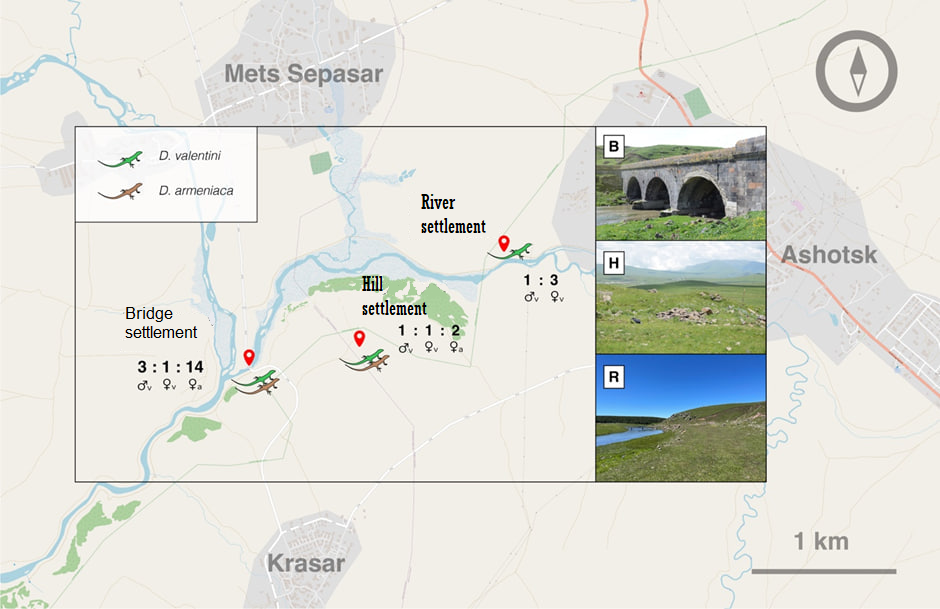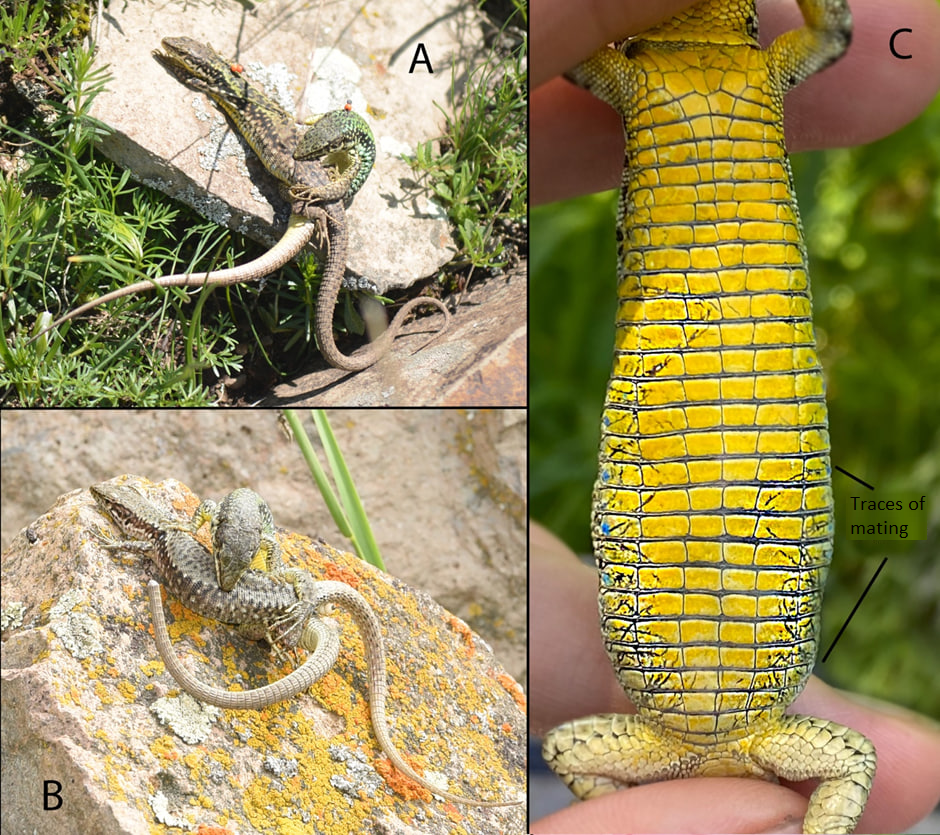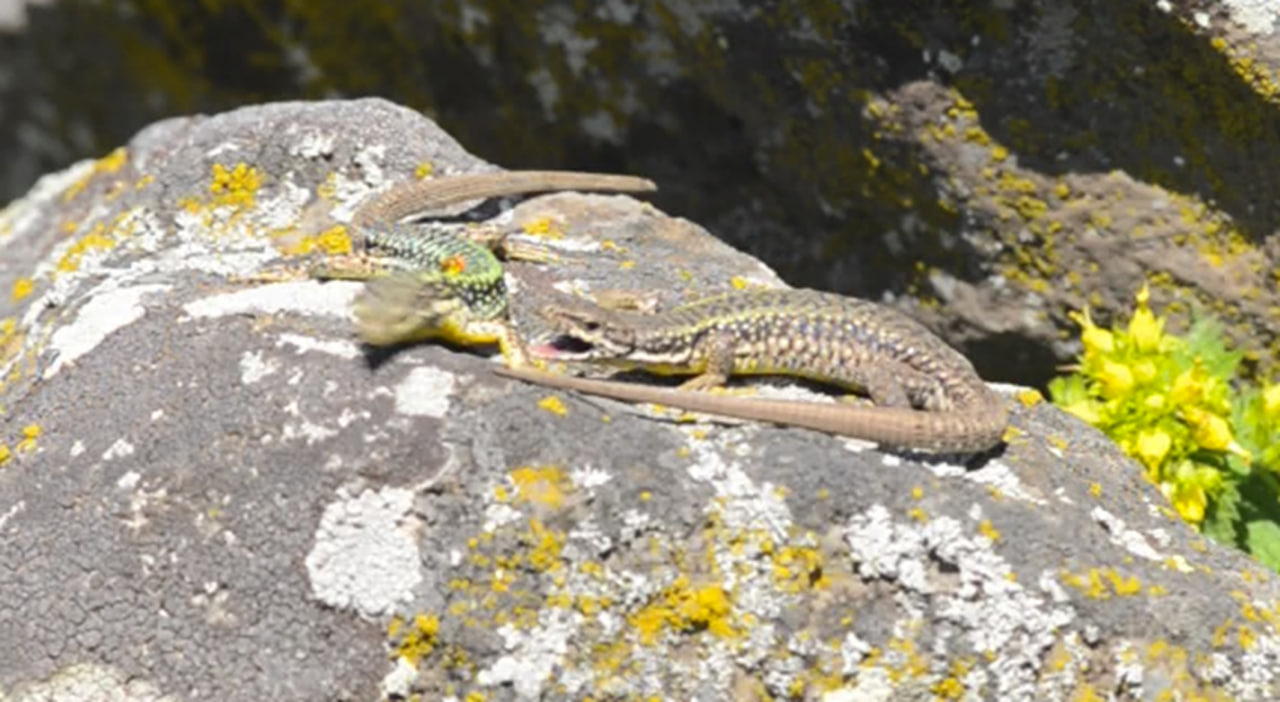
Fig. 1. Three studied settlements of rock lizards: near the river (D. valentini), the old bridge and on the hill (D. valentini + D. armeniaca). The ratio of species and sexes in each settlement is shown in the figure.
Parthenogenetic lizards, which reproduce without the participation of males, have arisen many times in different families of lizards. Almost all unisexual reptile species are clonal descendants of hybrids between two closely related species, from which they inherit their appearance and physiology. Unisexual females reproduce by laying unfertilized eggs, from which almost identical copies hatch. Peace and order reign in populations of unisexual species, since they do not have to compete for males, and they form settlements with a high population density, characterized by a low frequency of aggressive interactions. The modern range of unisexual hybrid species often overlaps with the range of one of the parents, where parthenogenetic females inevitably encounter males and females of a gonochoric species. In rock lizards of the genus Darevskia, hybrids with an additional set of chromosomes can arise in such places, since the gametes of unisexual females are diploid.
In order to understand the specifics of the relationships between males and females of gonochoric and parthenogenetic species, researchers from the A.N. Severtsov Institute of Ecology and Evolution of the Russian Academy of Sciences compared the reactions of males to females in a settlement where the parthenogenetic species D. armeniaca and its parent D. valetnini live simultaneously with the reactions between individuals in a settlement where only the gonochoric species D. valentini is found (Fig. 1). Both experimental sites were located in northern Armenia near the village of Mets Sepasar.

Fig. 2. Mating of a male D. valentini with a female of his own species (A) and a parthenogenetic female D. armeniaca (B). Traces on the body of a female D. valentini left after mating with males (C).
This allowed us to analyze the attractiveness of females of both species for males. It turned out that in places where a gonochoric species coexists with a parthenogenetic one, males more often prefer to mate with females of their own species, but they do not avoid females of a single-sex species at all. Visual observation of individually marked lizards produced the same results. At the same time, the number of females of a single-sex and gonochoric species in the studied settlement was more or less similar (Fig. 1).

At first glance, it may seem that unisexual females are unable to compete with hermaphrodite females in their attractiveness to males. However, the fact that we observed multiple matings with them and two-thirds of such females bear traces of mating suggests that they are not completely deprived of attention from males. Like hermaphrodite females, they engage in not only sexual but also social contact with males: they lie with them on rocks in the sun, hug and crawl over each other, which allows males to establish trusting relationships with them. On average, the reactions of gonochoric and hermaphrodite females to males did not differ. Competition between females of different species is evidenced by differences in the behavior of hermaphrodite females towards males in different populations. Where females do not have same-sex competitors, they were more aggressive towards males, and when approaching them during the breeding season, males were often faced with aggressive attacks and an open mouth (Fig. 3).
To overcome the resistance of females, males have to "win their trust" by carefully initiating social contacts and accustoming females to their presence. This is especially true for large and old females that are capable of standing up for themselves. However, in conditions of coexistence with females of a single-sex species, this behavioral strategy can turn into a disaster for females of a gonochoric species, so they become more compliant and do not show aggression towards males, just like females of a single-sex species. We believe that the pattern of relationships we have identified indicates that in single-species populations, sexual selection of males works more strictly than in populations where females of a gonochoric species have to deal with competitors who are attractive enough for males and capable of integrating into society on an equal basis with females of a gonochoric species. Unfortunately for males, mating with parthenogenetic females in the studied population does not lead to the appearance of hybrids. The current pattern of relationships between males of a gonochoric species and females of a parthenogenetic species may be part of a competitive exclusion mechanism, since if the reproductive effort of males is wasted on females from whom they do not produce offspring, the gonochoric females may gradually displace their hermaphrodite relatives.
The work was supported by the Russian Science Foundation grant 22-14-00227.
СсLink to the publication: Eduard A Galoyan, Natalia G Sopilko, Anna V Kovalyeva, Oleg D Nikolaev, Eugene S Iryshkov, Ivan I Kropachev, Ilya A Brinev, Anastasiya E Girnyk, Marine S Arakelyan. 2024. Love bites: males of lizards prefer to mate with conspecifics, but do not disdain parthenogens, Biological Journal of the Linnean Society, blae057.
